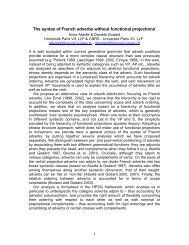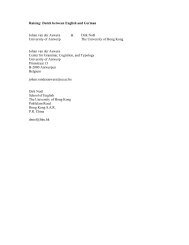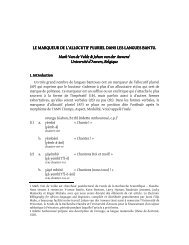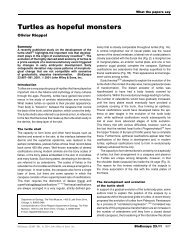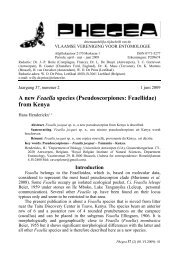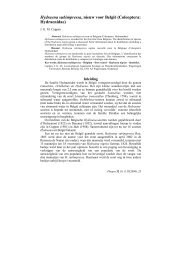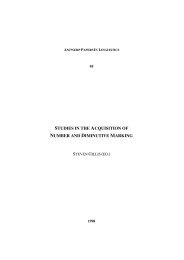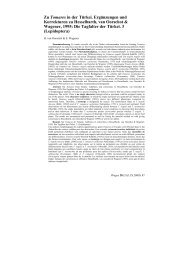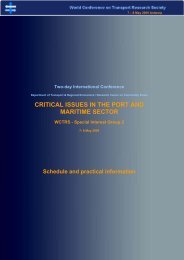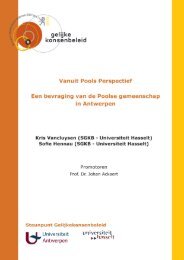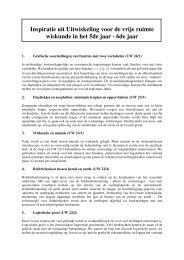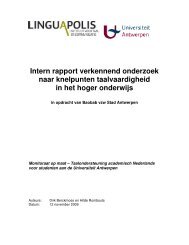Theodor2005.pdf
Theodor2005.pdf
Theodor2005.pdf
You also want an ePaper? Increase the reach of your titles
YUMPU automatically turns print PDFs into web optimized ePapers that Google loves.
Cebochoerid Deciduous Dentitions 179<br />
Lia Vella, Rob Furr, and three anonymous reviewers provided helpful comments on the<br />
manuscript.<br />
LITERATURE CITED<br />
Blainville, H. M. D. D. (1816). Prodrome d’une nouvelle distribution systèmatique du règne animal. Bull. Sci.<br />
Philomatique Paris 3 3: 105–124.<br />
Boisserie, J.-R., Lihoreau, F., and Brunet, M. (2005). The position of Hippopotamidae within Cetartiodactyla.<br />
Proc. Natl. Acad. Sci. U.S.A. 102: 1537–1541.<br />
Bremer, K. (1994). Branch support and tree stability. Cladistics 10: 295–304.<br />
Cifelli, R. L. (1982). The petrosal structure of Hyopsodus with respect to that of some other ungulates, and its<br />
phylogenetic implications. J. Paleontol. 56: 795–805.<br />
Colbert, E. H. (1935). Distributional and phylogenetic studies on Indian fossil mammals. IV. The phylogeny of<br />
the Indian Suidae and the origin of the Hippopotamidae. Am. Mus. Novit. 799: 1–24.<br />
Gatesy, J. (1997). More DNA support for a Cetacea/Hippopotamidae clade: The blood clotting protein gene<br />
γ -fibrinogen. Mol. Biol. Evol. 14: 537–543.<br />
Gatesy, J. (1998). Molecular evidence for the phylogenetic affinities of Cetacea. In: The Emergence of Whales:<br />
Evolutionary Patterns in the Origin of Cetacea, J. G. M. Thewissen, ed., pp. 63–112, Plenum, New York.<br />
Gatesy, J., Hayashi, C., Cronin, M. A., and Arctander, P. (1996). Evidence from milk casein genes that cetaceans<br />
are close relatives of hippopotamid artiodactyls. Mol. Biol. Evol. 13: 954–963.<br />
Gatesy, J., Milinkovitch, M., Waddell, V., and Stanhope, M. (1999). Stability of cladistic relationships between<br />
Cetacea and higher-level artiodactyl taxa. Syst. Biol. 48: 6–20.<br />
Geisler, J. H. (2001a). New morphological evidence for the phylogeny of Artiodactyla, Cetacea, and Mesonychidae.<br />
Am. Mus. Novit. 3344: 1–53.<br />
Geisler, J. H. (2001b). Possible resolution to the conflict between molecular and morphological evidence for the<br />
phylogeny of Artiodactyla. J. Vertebr. Paleontol. 21: 53A.<br />
Geisler, J. H., and Luo, Z. (1998). Relationships of Cetacea to terrestrial ungulates and the evolution of cranial<br />
vasculature in Cete. In: The Emergence of Whales: Evolutionary Patterns in the Origin of Cetacea, J. G. M.<br />
Thewissen, ed., pp. 163–212, Plenum, New York.<br />
Geisler, J. H., and Uhen, M. D. (2003). Morphological support for a close relationship between hippos and whales.<br />
J. Vertebr. Paleontol. 23(4): 991–996.<br />
Geisler, J. H., and Uhen, M. D. (2005). Phylogenetic relationships of extinct cetartiodactyls: Results of simultaneous<br />
analyses of molecular, morphological, and stratigraphic data. J. Mamm. Evol. 12 (in press).<br />
Gentry, A. W., and Hooker, J. J. (1988). The phylogeny of the Artiodactyla. In: The Phylogeny and Classification<br />
of the Tetrapods, Vol. 2: Mammals, M. J. Benton, ed., pp. 235–272, Clarendon, Oxford.<br />
Gingerich, P. D. (1998). Paleobiological perspectives on Mesonychia, Archaeoceti, and the origin of whales.<br />
In: The Emergence of Whales: Evolutionary Patterns in the Origin of Cetacea, J.G.M.Thewissen,ed.,<br />
pp. 423–450, Plenum, New York.<br />
Gingerich, P. D., Arif, M., and Clyde, W. C. (1995). New archaeocetes (Mammalia, Cetacea) from the middle<br />
Eocene Domanda Formation of the Sulaiman Range, Punjab (Pakistan). Contrib. Mus. Paleontol. Univ. Mich.<br />
29: 291–330.<br />
Gingerich, P. D., Haq, M. U., Zalmout, I. S., Khan, I. H., and Malkani, M. S. (2001). Origin of whales from early<br />
artiodactyls: Hands and feet of Eocene Protocetidae from Pakistan. Science 293: 2239–2242.<br />
Gingerich, P. D., and Russell, D. E. (1990). Dentition of early Eocene Pakicetus (Mammalia, Cetacea). Contrib.<br />
Mus. Paleontol. Univ. Mich. 28: 1–20.<br />
Graur, D., and Higgins, D. G. (1994). Molecular evidence for the inclusion of cetaceans within the Order<br />
Artiodactyla. Mol. Biol. Evol. 11: 357–364.<br />
Hooker, J. J., and Thomas, K. M. (2001). A new species of Amphirhagatherium (Choeropotamidae, Artiodactyla,<br />
Mammalia) from the Late Eocene Headon Hill Formation of Southern England and phylogeny of endemic<br />
European “anthracotherioids.” Palaeontology 44: 827–853.<br />
Hooker, J. J., and Weidmann, M. (2000). The Eocene mammal faunas of Mormont, Switzerland. Schweizerische<br />
Paläontologische Abhandlungen 120: 1–143.<br />
Hulbert, R. C. Jr., Petkewich, R. M., Bishop, G. A., Bukry, D., and Aleshire, D. P. (1998). A new middle Eocene<br />
protocetid whale (Mammalia: Cetacea: Archaeoceti) and associated biota from Georgia. J. Paleontol. 72:<br />
907–927.<br />
Luckett, W. P., and Hong, J. (1998). Phylogenetic relationships between the orders Artiodactyla and Cetacea: A<br />
combined assessment of morphological and molecular evidence. J. Mamm. Evol. 5: 127–182.<br />
MacLeod, N., and Rose, K. D. (1993). Inferring locomotor behavior in Paleogene mammals via eigenshape<br />
analysis. Am. J. Sci. 293-A: 300–355.



